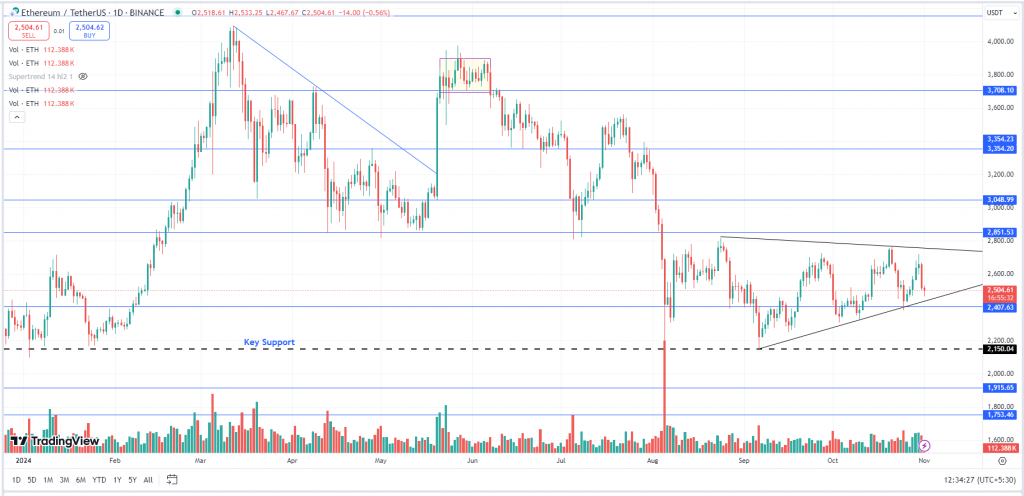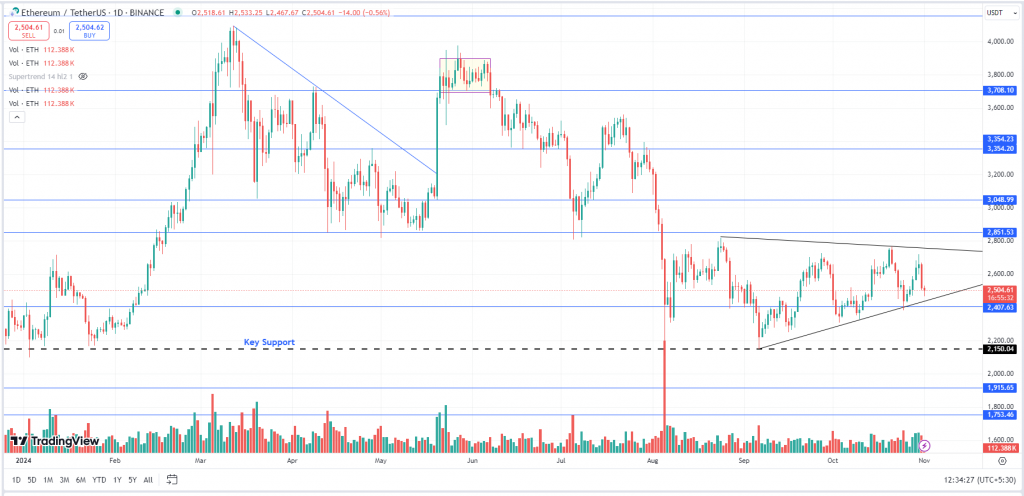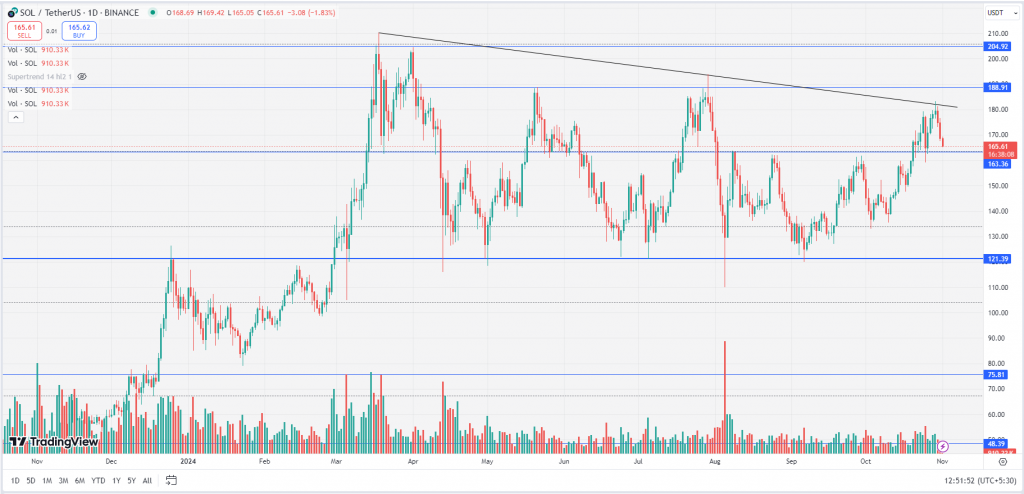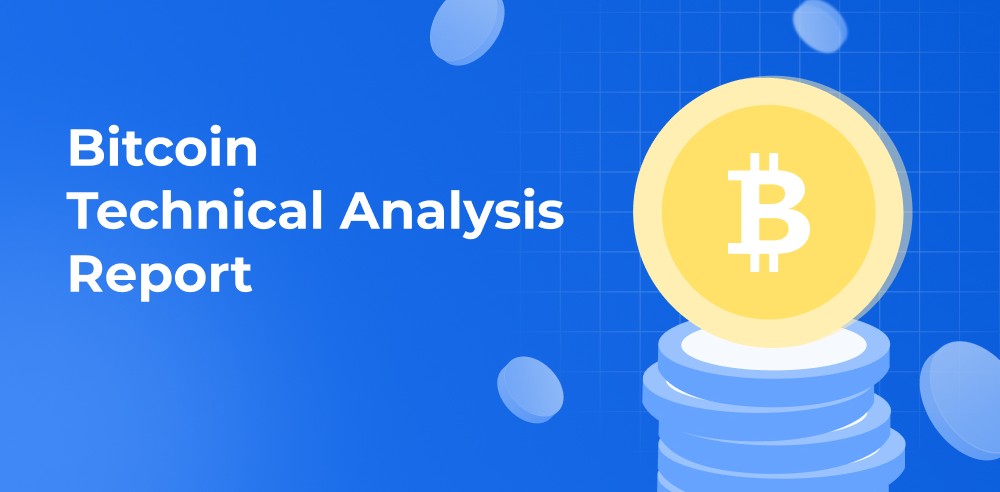Bitcoin (BTC), the world’s leading crypto, dropped below $70,000 after reaching a high of $72,000 the previous day, as investors exercise caution with the upcoming U.S. Presidential election. Major altcoins, including Ethereum (ETH), Dogecoin (DOGE), Solana (SOL), Ripple (XRP), and Litecoin (LTC), also traded in the red, reflecting a market-wide pullback. CoinMarketCap’s Market Fear & Greed Index showed a reading of 59 (Greed) out of 100, indicating an overall cautious optimism among traders. Ethena (ENA) emerged as the top performer with a 24-hour gain exceeding 5%, while Immutable (IMX) took the biggest hit, posting a loss of over 13% in the same period. The global crypto market cap stood at $2.29 trillion, reflecting a 24-hour decline of 5.66%. Coinbase shares came under significant pressure on Thursday, following the release of disappointing earnings and a cautious revenue outlook for the current quarter. The stock fell 15.3%, marking its largest drop since May 2022, when it declined by 19.5%. A broader market downturn added to the pressure on Coinbase. Other crypto-related stocks also took a hit. Robinhood, which similarly reported underwhelming earnings on Wednesday, saw its shares plummet by 16%. Crypto miners Marathon Digital Holdings and Riot Platforms followed suit, with declines of 8% and 11%, respectively.
Bitcoin saw an 11% rise in October, though it didn’t quite reach the typical gains seen in previous Octobers. Traders remain optimistic, anticipating a notable price move as demand surges across over-the-counter (OTC) exchanges. Starting the month at $65,634, Bitcoin closed October 31 at $72,335, marking an 11% increase—short of the 22% average October gain since 2013. Early in the month, the “Uptober” narrative faced doubt as Bitcoin dipped below $60,000 on October 11, hitting a low of $59,407 after a 7% drop over four days. However, by October 29, Bitcoin broke past $70,000 for the first time since June 7, rekindling bullish sentiment. Bitcoin dropped toward $71,000 as Wall Street opened on October 31, as U.S. macroeconomic data failed to provide fresh momentum for BTC’s upward trend. Analysis of exchange order books by trading resource Material Indicators showed Bitcoin whales had spent the previous 24 hours reducing their BTC holdings, forecasting that “volatility is only set to increase from here and into the next week.” Data from monitoring platform CoinGlass indicated that Bitcoin’s price was cutting through bid-side liquidity on its way toward $70,000. Despite this pullback, with only hours left until the October candle closed, BTC/USD was still up over 13% month-to-date.
On October 30, Ethereum’s price climbed to $2,700, its highest in ten days, before a sharp rejection on October 31 drove it back down to $2,550. Traders are now evaluating what it would take for Ether to reach the $3,000 mark. The answer likely lies in reducing transaction fees, increasing institutional adoption, and offering stronger incentives for ETH staking. Attributing Ether’s struggle to break above $2,700 solely to weak institutional demand oversimplifies the situation; this demand is more of an outcome of underlying issues than a direct cause. For example, Solana has recently overtaken Ethereum in decentralised application (DApp) transaction volumes. To address scalability concerns, Ethereum developers are working on Ethereum Improvement Proposal (EIP) 7742, which will introduce dynamic blob storage costs and caps on temporary data layers.
The September report for the Personal Consumption Expenditures (PCE) index largely aligned with market expectations, showing no unexpected deviations. Although this key inflation measure avoided any major surprises, it failed to ignite excitement in crypto markets, which showed a notably muted response. Despite stable inflation data, crypto investors seem cautious, perhaps waiting for more decisive macroeconomic signals or a clearer trend before making significant moves. As a result, the crypto market stayed in consolidation mode, reflecting an underlying sentiment of patience or unease in navigating the current economic landscape.
Technical Outlook:
BTC:

BTC, after making the all time high of $73,777, was trading in the ‘Descending Channel’ pattern. The asset gave a breakout above the channel and rallied up to $73,620. Bulls, however, failed to cross the previous all time and the prices witnessed some profit booking. BTC has struggled to give a weekly close above the $70K mark in the past. Once it gives a weekly close above $70,000, and sustains above the previous all time high, then we may expect it to rally further.
ETH:

ETH, after taking multiple support at $2,150, started to move in an upward direction. However, the asset is facing strong resistance at $2,800 to $2,850. Once it gives a breakout above the resistance, with good volumes, then we can expect it to further rally up to $3,350.
$2,400 to $2,350 will act as a strong support for the asset.
SOL:

SOL, after taking multiple support at the key level of $120, started moving upwards. The asset was facing stiff resistance at $165. SOL, last week, gave a breakout above the resistance of $165 and has made the weekly high of $183.38. It has a minor resistance at $185 to $190 (Downsloping Trendline). Once it breaks and sustains above these levels then we can expect it to further rally up to $205 to $210.
Weekly Snapshot:
| USD ($) | 24 Oct 24 | 31 Oct 24 | Previous Week | Current Week | |||
| Close | Close | % Change | High | Low | High | Low | |
| BTC | $68,161 | $70,215 | 3.01% | $69,463 | $65,188 | $73,577 | $65,522 |
| ETH | $2,535 | $2,516 | -0.75% | $2,766 | $2,457 | $2,720 | $2,381 |
| SOL | $177.16 | $168.43 | -4.93% | $179.00 | $149.40 | $183.04 | $160.04 |
| Crypto | 1w – % Vol. Change (Global) |
|---|---|
| Bitcoin (BTC) | 26.14% |
| Ethereum (ETH) | 20.76% |
| Solana (SOL) | 11.97% |
| Resistance 2 | $73,777 | $3,350 | $205 | $650 |
|---|---|---|---|---|
| Resistance 1 | $68,500 | $2,850 | $185 | $600 |
| USD | BTC | ETH | SOL | BNB |
| Support 1 | $66,000 | $2,400 | $160 | $525 |
| Support 2 | $62,0002`1 | $2,150 | $135 | $450 |
Market Updates:
- Bitcoin associated with the defunct Mt. Gox exchange is on the move again, with on-chain data showing a $35 million transfer to several unknown addresses on Nov. 1.
- Asia’s share of crypto developers surged to 32% in 2024, up from just 13% in 2015, positioning it as the leading region for developer talent in the crypto space. During this time, North America’s developer share significantly declined, falling from 44% in 2015 to 24%, as reported by Maria Shen, general partner at Electric Capital.
- In its Oct. 30 earnings call, MicroStrategy unveiled plans for an ambitious “21/21 Plan” to fuel a three-year, multibillion-dollar Bitcoin buying spree. The company aims to raise $21 billion in equity and an additional $21 billion in debt to support this extensive BTC acquisition strategy.
In the grand scheme of things, ZebPay blogs is here to provide you with crypto wisdom. Click on the button below and discover endless features on ZebPay!






